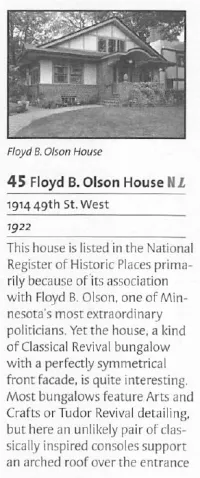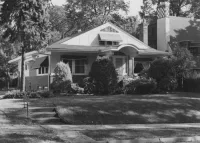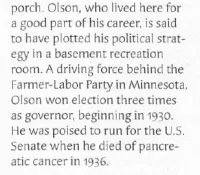Share what you know,
and discover more.
Share what you know,
and discover more.
Jan 01, 2009

-

- Charmaine Bantugan
1914 West 49th Street, Minneapolis, MN, USA
1914 West 49th Street Home History 1922 This house is listed in the National Register of Historic Places primarily because of its association with Floyd B. Olson, one of Minnesota's most extraordinary politicians. Yet the house, a kind of Classical Revival bungalow with a perfectly symmetrical front façade, is quite interesting. Most bungalows feature Arts and Crafts or Tudor Revival detailing, but here an unlikely pair of classically inspired consoles support an arched roof over the entrance porch. Olson, who lived here for a good part of his career, is said to have plotted his political strategy in a basement recreation room. A driving force behind the Farmer-Labor Party in Minnesota, Olson won election three times as governor, beginning in 1930. He was poised to run for the U.S. Senate when he died of pancreatic cancer in 1936. Citation: Millett, Larry. AIA Guide to the Minneapolis Lake District. Minnesota Historical Society Press, 2009.
1914 West 49th Street, Minneapolis, MN, USA
1914 West 49th Street Home History 1922 This house is listed in the National Register of Historic Places primarily because of its association with Floyd B. Olson, one of Minnesota's most extraordinary politicians. Yet the house, a kind of Classical Revival bungalow with a perfectly symmetrical front façade, is quite interesting. Most bungalows feature Arts and Crafts or Tudor Revival detailing, but here an unlikely pair of classically inspired consoles support an arched roof over the entrance porch. Olson, who lived here for a good part of his career, is said to have plotted his political strategy in a basement recreation room. A driving force behind the Farmer-Labor Party in Minnesota, Olson won election three times as governor, beginning in 1930. He was poised to run for the U.S. Senate when he died of pancreatic cancer in 1936. Citation: Millett, Larry. AIA Guide to the Minneapolis Lake District. Minnesota Historical Society Press, 2009.
Jan 01, 2009
1914 West 49th Street, Minneapolis, MN, USA
1914 West 49th Street Home History1922
This house is listed in the National Register of Historic Places primarily because of its association with Floyd B. Olson, one of Minnesota's most extraordinary politicians. Yet the house, a kind of Classical Revival bungalow with a perfectly symmetrical front façade, is quite interesting. Most bungalows feature Arts and Crafts or Tudor Revival detailing, but here an unlikely pair of classically inspired consoles support an arched roof over the entrance porch. Olson, who lived here for a good part of his career, is said to have plotted his political strategy in a basement recreation room. A driving force behind the Farmer-Labor Party in Minnesota, Olson won election three times as governor, beginning in 1930. He was poised to run for the U.S. Senate when he died of pancreatic cancer in 1936.
Citation: Millett, Larry. AIA Guide to the Minneapolis Lake District. Minnesota Historical Society Press, 2009.
Posted Date
Oct 05, 2023
Historical Record Date
Jan 01, 2009
Source Name
AIA Guide to the Minneapolis Lake District
Delete Story
Are you sure you want to delete this story?
Jul 12, 1974
Jul 12, 1974

-

- Charmaine Bantugan
Floyd B. Olson House - National Register of Historic Places
Statement of Significance: In 1930, Olson ran for governor on the Farmer-Labor ticket and defeated his Republican opponent by a large majority of the votes. Never before had a Republican candidate been so roundly defeated in Minnesota, Those who voted for him voiced a protest against the accumulating misfortunes caused by depression. Olson's first administration was conservative -- with a Republican legislature there was little chance of getting controversial measures passed by his opponents. With his reelection in 1932, however, Olson effected a political alliance with Franklin D. Roosevelt, and thereafter his policies reflected those of the New Deal. The deepening depression created a general spirit of desperation in rural areas; farmers began to adopt some of the tactics of trade unions. This radical drift of popular sentiment was most congenial to Olson; he edged slowly leftward in order to extend the functions of government for the benefit of the underprivileged. During his second term as governor Olson was primarily responsible for the suspension of mortgage payments -- which provided a measure of relief until the federal government could institute a large-scale program for agriculture. He approved a cluster of labor bills which prohibited yellow-dog contracts, limited women on industrial jobs to a fifty-four-hour week, and outlawed the use of injunctions in labor disputes. Constructive work was done in the field of conservation. Besides conservation, labor, and tax legislation Olson effected a strengthening of the securities law and a beginning of statewide old age pensions. The fall of 1933 saw the emergence of Olson as a national figure. His exposition of radicalism, his dramatic threat to invoke martial law to relieve destitution, his participation in a delegation of northwestern governors demanding agricultural price relief in Washington, and his support and constructive criticism of the New Deal recovery program all attracted nationwide notice. Olson won a second reelection in 1934. The most constructive work accomplished during his third term as governor was in the field of labor. In 1935 he played a major role as mediator in a number of strikes. The successful strikes of 1935 climaxed Olson's long fight for collective bargaining. On August 22, 1936 Olson died at the Mayo Clinic of pancreatic cancer. After a moving display of public grief, he was buried in Lakewood Cemetery, Minneapolis. Olson's death marked the apex of Farmer-Labor power. Thereafter, the party declined rapidly as an independent political force.
Floyd B. Olson House - National Register of Historic Places
Statement of Significance: In 1930, Olson ran for governor on the Farmer-Labor ticket and defeated his Republican opponent by a large majority of the votes. Never before had a Republican candidate been so roundly defeated in Minnesota, Those who voted for him voiced a protest against the accumulating misfortunes caused by depression. Olson's first administration was conservative -- with a Republican legislature there was little chance of getting controversial measures passed by his opponents. With his reelection in 1932, however, Olson effected a political alliance with Franklin D. Roosevelt, and thereafter his policies reflected those of the New Deal. The deepening depression created a general spirit of desperation in rural areas; farmers began to adopt some of the tactics of trade unions. This radical drift of popular sentiment was most congenial to Olson; he edged slowly leftward in order to extend the functions of government for the benefit of the underprivileged. During his second term as governor Olson was primarily responsible for the suspension of mortgage payments -- which provided a measure of relief until the federal government could institute a large-scale program for agriculture. He approved a cluster of labor bills which prohibited yellow-dog contracts, limited women on industrial jobs to a fifty-four-hour week, and outlawed the use of injunctions in labor disputes. Constructive work was done in the field of conservation. Besides conservation, labor, and tax legislation Olson effected a strengthening of the securities law and a beginning of statewide old age pensions. The fall of 1933 saw the emergence of Olson as a national figure. His exposition of radicalism, his dramatic threat to invoke martial law to relieve destitution, his participation in a delegation of northwestern governors demanding agricultural price relief in Washington, and his support and constructive criticism of the New Deal recovery program all attracted nationwide notice. Olson won a second reelection in 1934. The most constructive work accomplished during his third term as governor was in the field of labor. In 1935 he played a major role as mediator in a number of strikes. The successful strikes of 1935 climaxed Olson's long fight for collective bargaining. On August 22, 1936 Olson died at the Mayo Clinic of pancreatic cancer. After a moving display of public grief, he was buried in Lakewood Cemetery, Minneapolis. Olson's death marked the apex of Farmer-Labor power. Thereafter, the party declined rapidly as an independent political force.
Floyd B. Olson House - National Register of Historic Places
Statement of Significance:In 1930, Olson ran for governor on the Farmer-Labor ticket and defeated his Republican opponent by a large majority of the votes. Never before had a Republican candidate been so roundly defeated in Minnesota, Those who voted for him voiced a protest against the accumulating misfortunes caused by depression.
Olson's first administration was conservative -- with a Republican legislature there was little chance of getting controversial measures passed by his opponents. With his reelection in 1932, however, Olson effected a political alliance with Franklin D. Roosevelt, and thereafter his policies reflected those of the New Deal.
The deepening depression created a general spirit of desperation in rural areas; farmers began to adopt some of the tactics of trade unions. This radical drift of popular sentiment was most congenial to Olson; he edged slowly leftward in order to extend the functions of government for the benefit of the underprivileged.
During his second term as governor Olson was primarily responsible for the suspension of mortgage payments -- which provided a measure of relief until the federal government could institute a large-scale program for agriculture. He approved a cluster of labor bills which prohibited yellow-dog contracts, limited women on industrial jobs to a fifty-four-hour week, and outlawed the use of injunctions in labor disputes. Constructive work was done in the field of conservation. Besides conservation, labor, and tax legislation Olson effected a strengthening of the securities law and a beginning of statewide old age pensions.
The fall of 1933 saw the emergence of Olson as a national figure. His exposition of radicalism, his dramatic threat to invoke martial law to relieve destitution, his participation in a delegation of northwestern governors demanding agricultural price relief in Washington, and his support and constructive criticism of the New Deal recovery program all attracted nationwide notice.
Olson won a second reelection in 1934. The most constructive work accomplished during his third term as governor was in the field of labor. In 1935 he played a major role as mediator in a number of strikes. The successful strikes of 1935 climaxed Olson's long fight for collective bargaining.
On August 22, 1936 Olson died at the Mayo Clinic of pancreatic cancer. After a moving display of public grief, he was buried in Lakewood Cemetery, Minneapolis. Olson's death marked the apex of Farmer-Labor power. Thereafter, the party declined rapidly as an independent political force.
Posted Date
Mar 09, 2022
Historical Record Date
Jul 12, 1974
Source Name
United States Department of Interior - National Park Service
Source Website
Delete Story
Are you sure you want to delete this story?











